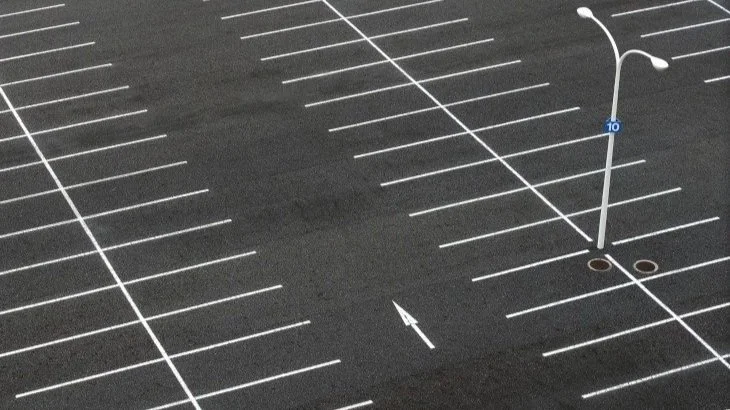The Importance of Parking Lot Layout and Striping for Safer, Smoother Traffic Flow
Parking lots are often the first point of contact customers, tenants, or visitors have with your business or property. A well-designed layout and precise striping not only create a professional appearance but also ensure smooth traffic flow, reduce accidents, and maximize parking capacity. In fact, studies show that effective striping can increase parking efficiency by up to 20% while improving driver and pedestrian safety.
In this article, we’ll explore why parking lot layout and striping matter, how they directly affect traffic patterns and safety, and the best practices property owners should follow to get the most out of their investment.
The Role of Parking Lot Design in Traffic Flow
The design of a parking lot sets the foundation for how vehicles move through the space. A poor layout can cause bottlenecks, driver frustration, and even fender benders. On the other hand, a properly engineered plan guides drivers naturally and safely.
Key Design Considerations:
Traffic Lanes and Flow Direction: Clearly marked one-way and two-way lanes prevent confusion. Angled parking is often paired with one-way lanes to ease navigation.
Entry and Exit Points: Proper placement reduces congestion at busy intersections or building entrances.
Pedestrian Pathways: Dedicated crosswalks and sidewalks protect pedestrians and reduce liability risks.
Emergency Access: Fire lanes and unobstructed routes are legally required and essential for safety.
By aligning layout with expected traffic volume, property owners can prevent choke points and ensure vehicles circulate efficiently.
Why Parking Lot Striping Is Critical for Safety
Striping transforms an empty asphalt surface into an organized, user-friendly system. Without fresh, visible lines, confusion quickly arises, leading to wrong-way driving, unsafe parking, and increased accident risk.
Safety Benefits of Professional Striping:
Defines Parking Spaces: Prevents overcrowding and improper vehicle spacing.
Guides Drivers Clearly: Arrows, stop bars, and lane dividers reduce guesswork.
Protects Pedestrians: Crosswalks and ADA-compliant markings highlight safe walking zones.
Supports Compliance: Proper markings keep your property aligned with state, local, and ADA regulations.
Over time, faded striping compromises these safety benefits. Industry best practice recommends restriping every 18–24 months, depending on traffic volume and weather exposure.
Maximizing Parking Efficiency with Proper Layout
One of the biggest mistakes property owners make is underestimating how much layout affects capacity. Simply changing the angle or arrangement of stalls can add dozens of spaces without expanding the lot.
Common Layout Styles:
90-Degree Parking: Maximizes number of spaces but requires more maneuvering.
60-Degree Parking: Easier for drivers, often used in retail environments.
Parallel Parking: Useful in tight or narrow spaces but limits total capacity.
Well-planned layouts strike a balance between ease of navigation and maximizing stall count. For businesses, this means accommodating more customers without costly expansions.
ADA Compliance and Accessibility
Parking lot design and striping aren’t just about convenience—they’re a legal requirement. The Americans with Disabilities Act (ADA) mandates specific ratios of accessible spaces, dimensions, and signage.
ADA Requirements to Keep in Mind:
Accessible Space Count: Based on total lot capacity.
Van-Accessible Stalls: Wider spaces with proper aisle markings.
Signage and Markings: Must include universally recognized symbols.
Failing to comply can result in hefty fines and potential lawsuits, in addition to putting vulnerable populations at risk.
Pedestrian Safety: A Core Priority
While much attention is given to vehicles, pedestrians are often the most vulnerable. A parking lot should feel safe and intuitive for those walking from their car to the building.
Best Practices for Pedestrian Safety:
Marked crosswalks with bold striping.
Stop bars at crosswalks to slow vehicles.
Lighting and reflective paint for nighttime visibility.
Clearly separated loading zones to avoid mixing pedestrians with delivery traffic.
These design features reduce liability and create a welcoming, safe environment.
Long-Term Maintenance and Restriping
Even the best layout and striping fade over time due to weather, UV exposure, and heavy traffic. A proactive maintenance plan ensures your lot remains safe and professional.
Maintenance Tips:
Sealcoating: Protects asphalt from cracks and extends life.
Regular Inspections: Spot fading lines or potholes early.
Scheduled Restriping: Every 1–2 years depending on usage.
A faded parking lot doesn’t just look unprofessional—it creates real safety hazards. Property owners who maintain their lots consistently spend less in the long run and avoid costly liabilities.
The Business Benefits of Proper Layout and Striping
Beyond safety and efficiency, a well-marked parking lot directly impacts your business reputation.
Professional Appearance: First impressions matter—organized lots reflect care and professionalism.
Customer Satisfaction: Easy navigation reduces stress and improves the visitor experience.
Reduced Liability: Safer lots mean fewer accidents and insurance claims.
Higher Property Value: A well-maintained lot is an asset for resale or leasing.
Conclusion
Parking lot layout and striping may seem like small details, but they make a big difference in how safely and efficiently your property operates. From guiding drivers to protecting pedestrians and maximizing capacity, investing in professional design and striping pays dividends in safety, compliance, and customer satisfaction.
At Jem Paving, we specialize in parking lot layout, striping, sealcoating, and asphalt maintenance. Whether you need a fresh design, compliance upgrades, or restriping to restore visibility, our team is here to help. Contact us today for a consultation and ensure your parking lot is safe, efficient, and professional.

